Yes, you can use a carpet cleaner on many types of rugs, but it’s essential to consider the rug’s material and construction before proceeding. While carpet cleaners are effective for deep cleaning, some rugs require special care to prevent damage.
Understanding the Difference: Rug vs. Carpet
The primary distinction between a rug and a carpet lies in their installation and mobility. Rugs are movable textile floor coverings that come in a variety of shapes, sizes, and designs. They are typically placed over hard floors such as tile, wood, or laminate to add style, warmth, or protection. Common examples include area rugs, oriental rugs, and runner rugs—all of which can be easily rolled up or replaced.
In contrast, carpets are permanent or semi-permanent fixtures that cover an entire room from wall to wall. They are secured to the floor using tacks, glue, or stretching equipment. Carpets are common in bedrooms, living rooms, and other high-traffic areas because they provide insulation, noise reduction, and continuous underfoot comfort.
Why This Distinction Matters for Cleaning
Understanding the difference between rugs and carpets is essential when it comes to cleaning because carpet cleaners are engineered primarily for wall-to-wall carpets. These machines are designed to clean large, fixed surfaces and often involve water, suction, and cleaning solutions that may not be safe for all rug types.
Since rugs vary significantly in terms of material, construction, and backing, they may respond poorly to moisture or harsh chemicals. For example, cleaning a wool or silk rug with a standard carpet shampooer could result in color bleeding, shrinkage, or fiber damage. Additionally, some rugs have delicate bindings or glues that can break down when exposed to high heat or aggressive suction.
On the other hand, some synthetic or low-pile rugs are durable enough to handle carpet cleaner usage, especially if the cleaner is used carefully and sparingly. This is why knowing whether you’re dealing with a rug or a carpet—and the rug’s specific material—is crucial before deciding how to clean it.
Types of Rugs and Their Cleaning Needs
Different materials react differently to moisture, heat, and cleaning chemicals. Knowing your rug’s composition is key to safe rug cleaning.
Common Rug Types and Their Cleaning Requirements

Here’s a breakdown of popular rug materials and how they should be cleaned:
Wool Rugs
Wool is a natural fiber known for its durability and insulation. While it can withstand foot traffic and is generally long-lasting, wool is sensitive to excessive water and harsh chemicals. Using too much moisture during rug washing can cause shrinkage, while aggressive agitation can damage the fibers. Spot cleaning and dry-cleaning methods are often preferred. If needed, consult professionals for oriental rug cleaning if the wool rug is handmade or antique.
Synthetic Rugs (e.g., Nylon, Polyester, Olefin)
These rugs are more resilient and easier to clean. They are typically compatible with carpet cleaners, making area rug carpet cleaning more straightforward. They handle moisture and detergent better than natural fibers, making them ideal for families, pets, or high-traffic areas. For diy rug cleaning, synthetic rugs are often the safest bet.
Shag Rugs
Known for their plush, high-pile surface, shag rugs are cozy but also dirt magnets. Their thick fibers trap dust, hair, and debris deep within the pile, making routine vacuuming difficult. Rug deep cleaning may be necessary more frequently. However, their fibers can tangle or fray if cleaned too aggressively. Gentle suction and a mild cleaning solution work best here, or you may consider professional rug cleaning if the rug is heavily soiled.
Oriental Rugs (e.g., Persian, Turkish)
Often hand-knotted and made of natural materials like silk or wool, these rugs are valuable and delicate. Water, chemicals, or improper cleaning tools can easily damage them. For oriental rug cleaning, always consult a specialist. Avoid using regular carpet rug cleaning machines on these; spot cleaning with a pH-neutral solution may be the only safe at-home option.
Jute or Sisal Rugs
These are made from plant-based fibers and are highly absorbent. Introducing moisture can lead to mildew, warping, or staining. These rugs should never be overly wet. Instead, stick to dry-cleaning powders or vacuuming for maintenance. How to clean a rug at home by hand using dry methods is especially relevant here.
How Carpet Cleaners Work
There are different methods of rug washing using carpet cleaners:
- Steam Cleaning: Uses heat and water to break down dirt. Best for deep carpet rug cleaning, but avoid on heat-sensitive rugs.
- Shampooing: Uses cleaning solutions and brushes—ideal for synthetic or durable rugs.
- Dry Cleaning: Involves little moisture, great for rugs that can’t get too wet.
Inside a carpet cleaning solution:
Most contain detergents, deodorizers, and sometimes disinfectants. Avoid bleach or harsh chemicals when doing diy rug cleaning.
How to Clean a Rug at Home
Cleaning a rug with a carpet cleaner can be highly effective if done correctly. However, improper technique or incompatible cleaning solutions can lead to fiber damage, discoloration, or even mold growth. Follow this detailed, step-by-step approach to ensure your rug cleaning is safe and successful.
1. Vacuum Thoroughly
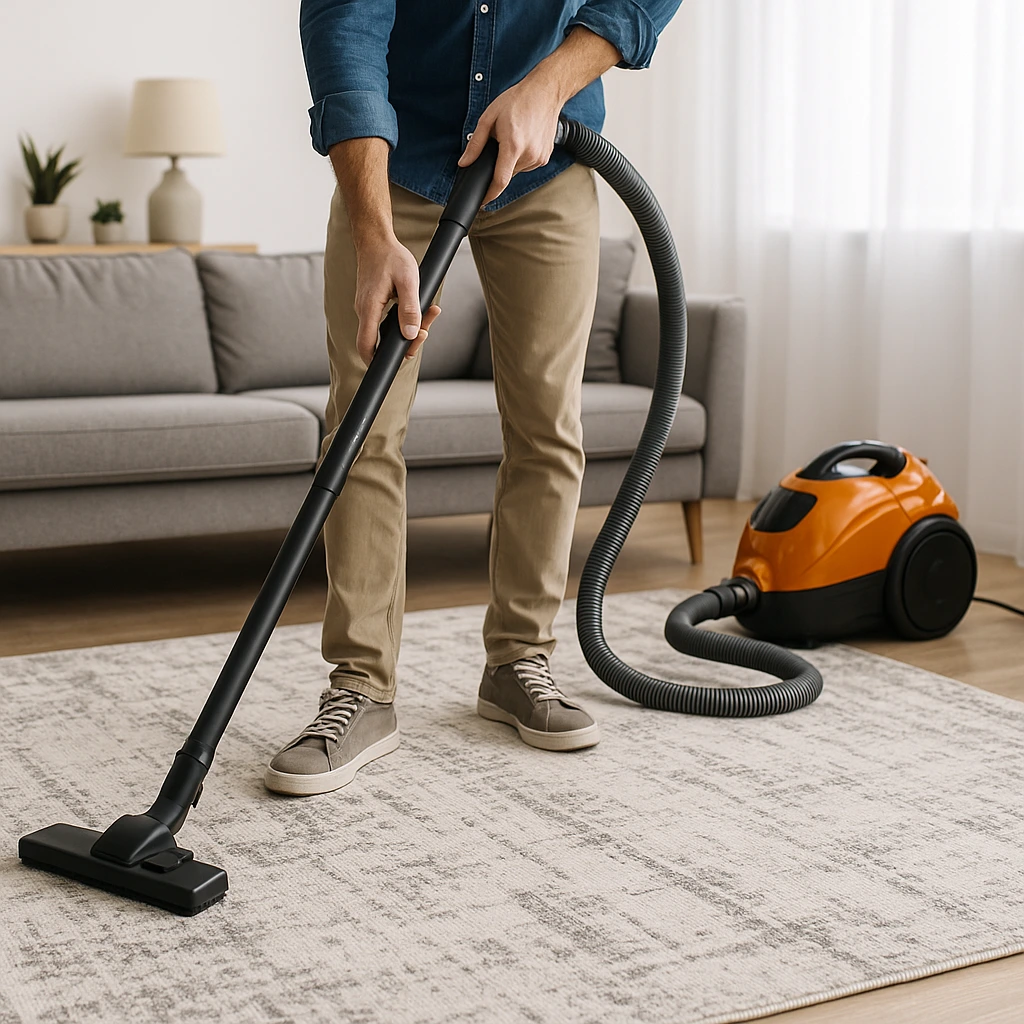
Start by vacuuming both the front and back of the rug. This is a crucial first step that removes loose dirt, dust, pet hair, and debris. Vacuuming not only makes the deep cleaning process more effective, but it also prevents the dirt from turning into muddy residue when wet. For area rug cleaning, use a vacuum with adjustable suction to avoid pulling delicate fibers.
2. Perform a Spot Test
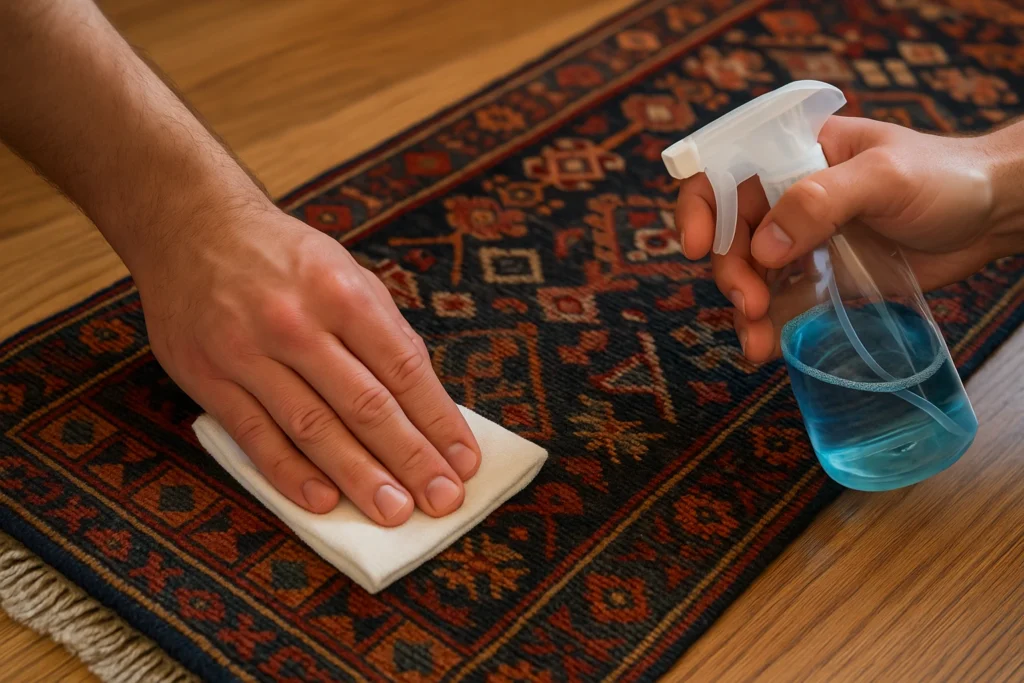
Before applying any cleaning solution to the entire rug, test a small, inconspicuous section—preferably near a corner or edge. This is important to ensure the rug’s dyes are colorfast and won’t bleed or fade. Apply a small amount of diluted cleaner and blot with a white cloth. If no color transfers, it’s safe to proceed. This is especially critical for oriental rug cleaning or natural fiber rugs.
3. Prepare the Cleaning Solution
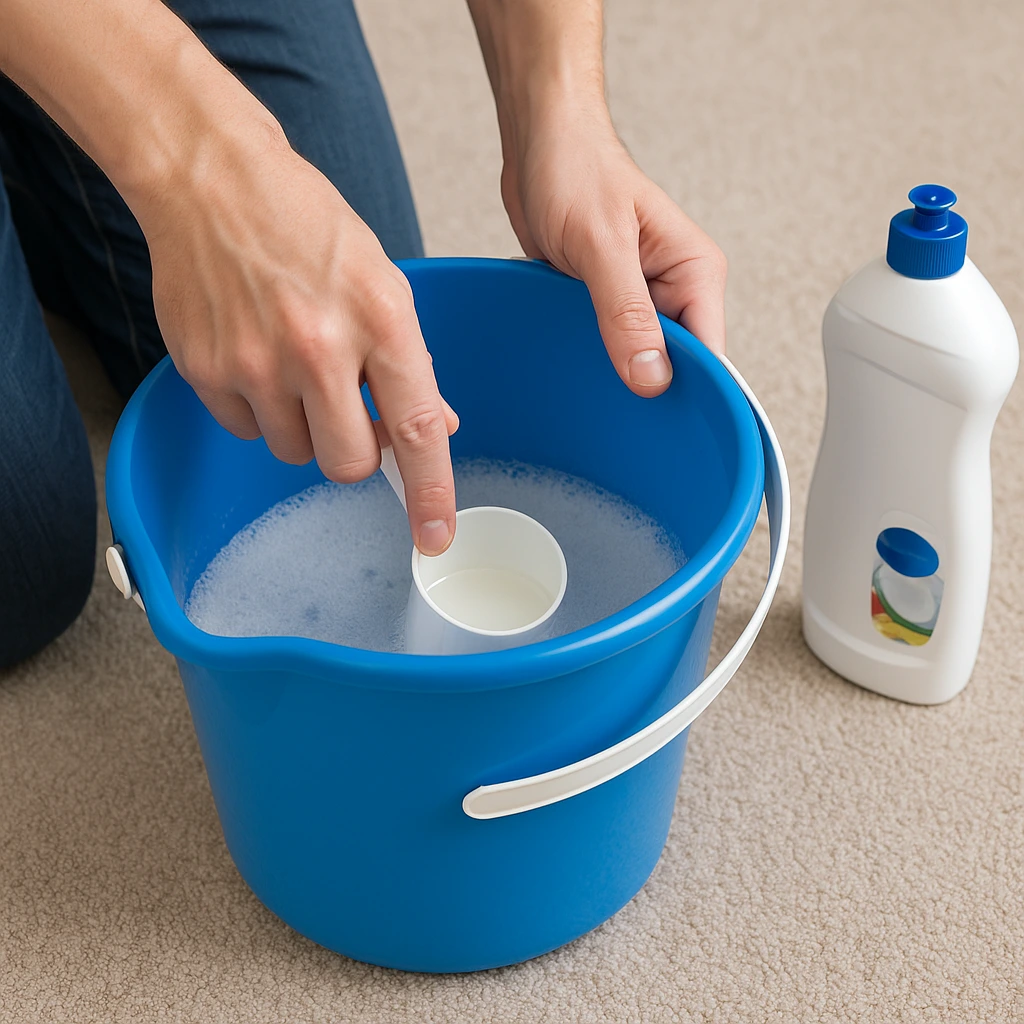
Use a rug-safe detergent that’s designed for your rug type. Avoid bleach or ammonia-based products, which can break down natural fibers and ruin the rug’s texture and color. Mix the solution with warm water according to the manufacturer’s instructions. If you’re opting for DIY rug cleaning, you can also make a gentle solution using mild dish soap and water. Avoid over-saturating the rug during this step.
4. Clean the Rug
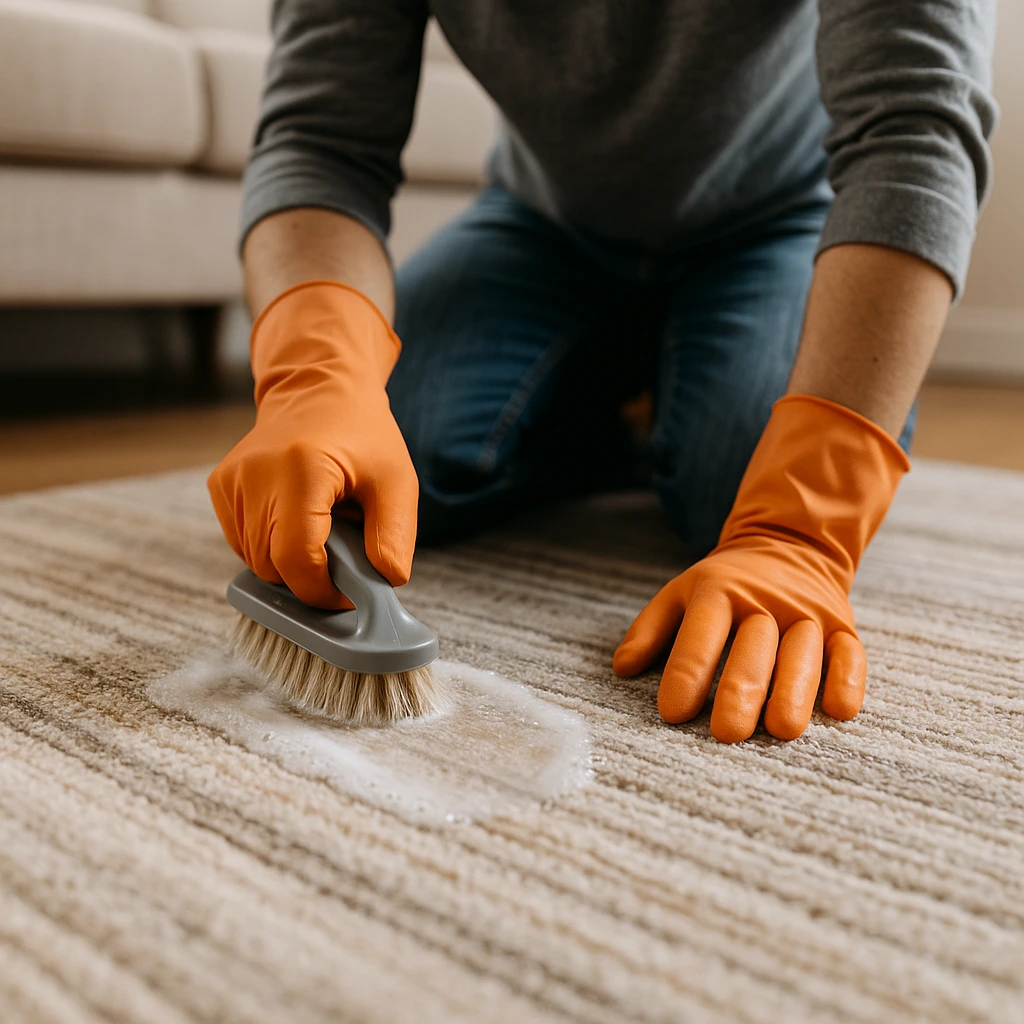
Whether you’re using a carpet cleaner machine or cleaning by hand, work in small sections. Apply the cleaning solution and scrub gently with a soft brush or cloth, always moving in the direction of the rug’s pile. For shag rugs, use less pressure to prevent fiber tangling. For machine-based carpet rug cleaning, attach the upholstery or spot-cleaning tool to maintain control and precision. Make sure not to overwet the rug—too much moisture can lead to mildew or backing damage.
5. Rinse Thoroughly
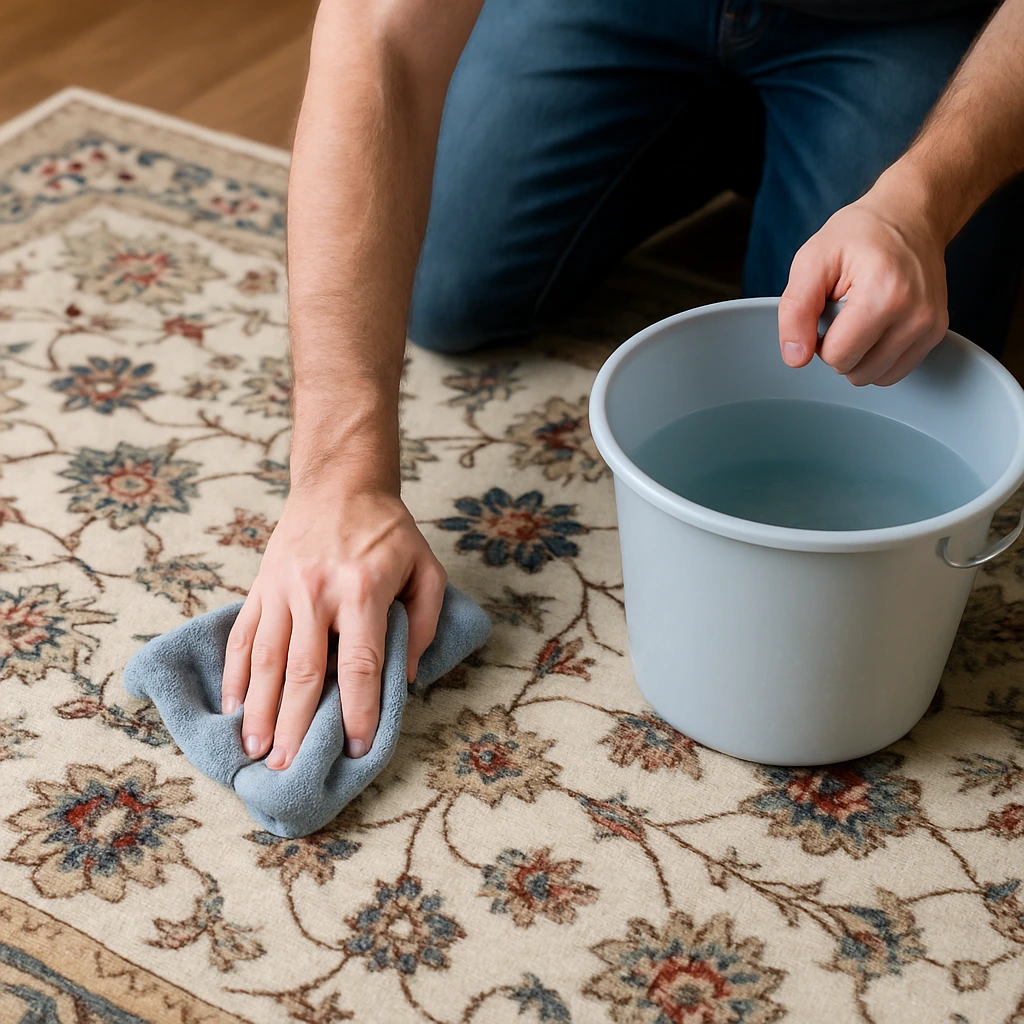
After cleaning, it’s essential to rinse out all soap residue, which can attract more dirt if left behind. Use a clean cloth dipped in water to blot and remove any detergent. For larger rugs, you may use a hose with a light spray setting—but only for synthetic or outdoor-safe rugs. Avoid oversaturating the rug, especially with jute, wool, or oriental rugs, as they retain water easily.
6. Dry the Rug Completely

Drying is one of the most critical steps in the rug washing process. Lay the rug flat in a well-ventilated space, preferably outdoors under a shaded area. Flip it periodically to ensure both sides dry evenly, which helps prevent mold and odors. Avoid direct sunlight, especially for colored or antique rugs, as it can cause fading. You can also place a fan nearby to speed up the drying process.
Tips for Specific Rug Types
- Area Rugs: Most area rugs can be cleaned with a carpet cleaner, but always check the manufacturer’s instructions.
- Shag Rugs: Due to their long fibers, shag rugs can trap dirt easily. Use a carpet cleaner with care, and consider professional cleaning for deep stains.
- Natural Fiber Rugs: Rugs made from jute, sisal, or seagrass are sensitive to moisture. Avoid using water-based cleaners; instead, use dry cleaning methods or consult a professional.
DIY Rug Cleaning Solutions
For a natural cleaning solution, mix equal parts white vinegar and water. This mixture can help remove odors and light stains. Always test on a small area first.
When to Seek Professional Help
If your rug is antique, made of delicate materials, or has significant staining, it’s best to consult a professional rug cleaner. They have the expertise and equipment to clean your rug safely and effectively.
FAQs
1: Can I use a carpet cleaner on an area rug over hardwood floors?
It’s not recommended to use a carpet cleaner on a rug placed over hardwood floors, as moisture can damage the wood. Always move the rug to a safe area before cleaning.
2: How often should I clean my rugs?
For high-traffic areas, clean rugs every 6-12 months. Less frequented areas can be cleaned annually.
3: Is it safe to use a carpet cleaner on a wool rug?
Yes, but with caution. Use cold water, a wool-safe detergent, and avoid over-wetting. Always test a small area first
4: Can I clean a rug without moving it?
While spot cleaning is possible, for thorough cleaning, it’s best to move the rug to prevent damage to the flooring underneath.
5: What should I do if colors bleed during cleaning?
Stop cleaning immediately and blot the area with a dry cloth. Consult a professional to address color bleeding issues
Conclusion
So, can you use a carpet cleaner on a rug? Yes—but only on the right types of rugs and with proper preparation. Always consider your rug’s material and condition before proceeding. While rug cleaners offer a convenient option for many, delicate or antique rugs require a gentler touch. Whether it’s a deep rug clean or simple spot cleaning, the best way to clean rugs depends on the balance between effective cleaning and preserving your rug’s integrity.
Disclaimer
Content on Home Trending Tips is for informational purposes only. Please consult professionals before making home or garden decisions.



